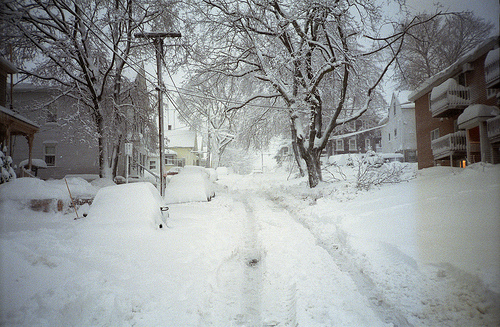A Way to Battle Blizzards with a Simple Shovel
 The blizzard that paralyzed New York at the end of the 2010 won’t be the last big snowstorm of the season. But you don’t need to be immobilized by a blizzard. Waiting for the snowblower can leave you with dangerous, icy conditions. Here's how to keep your walkways safe, using a good, old-fashioned shovel:
The blizzard that paralyzed New York at the end of the 2010 won’t be the last big snowstorm of the season. But you don’t need to be immobilized by a blizzard. Waiting for the snowblower can leave you with dangerous, icy conditions. Here's how to keep your walkways safe, using a good, old-fashioned shovel:
Prepare for a Blizzard
If you live in a blizzard-prone area (and recent weather patterns indicate an ever-larger swath of the country fits that bill), be prepared with emergency equipment and shoveling gear.
Make a family escape plan in case you are trapped. Also make sure you have an accessible flashlight, first aid kit and battery-powered radio, as well as extra food, water and blankets.
Keep a snow shovel accessible, and know where to find it — in the dark, if necessary. You can’t use the shovel to dig out your car if you need to move the car to get to the shovel.
Start Shoveling Early
After the blizzard hits, start shoveling early. Moving several feet of snow at once after the snow stops falling can be overwhelming. Start while it is still snowing, if possible.
Shovel in the afternoon. Temperatures are near their peak, and doctors say you are less likely to injure your back because there is less pressure on your back’s discs in the afternoon. Try to clear off the snow before it refreezes and gets icy overnight.
You may have to shovel the same driveway or sidewalk twice, but avoid shoveling the same snow twice. Be sure to plan ahead, and dump the snow away from the driveway or path so you don’t have to toss it again.
Dress in warm, comfortable layers, and take it slow. Shoveling snow can be dangerous for both your heart and back. In a Michigan study, healthy men in their 20s and 30s reported equally elevated heart rates after 10 minutes of snow shoveling as after running on a treadmill at their maximum pace. For older or less fit people, heart attacks are a serious risk.
For others, back pain and strained muscles are more likely. To minimize the risk, the American Academy of Orthopedic Surgeons offers the following snow-shoveling tips:
• Warm up with 10 minutes of light calisthenics before going outside.
• Pace yourself, take regular breaks and drink plenty of fluids
• Don’t use shovels that are too heavy or long for you to use comfortably. Shovels with bent handles are designed to minimize stooping.
• Push the snow instead of lifting and heaving it, whenever possible. Lift with your legs, not your back, when necessary.
• Don’t throw snow over your shoulder or your side. This can strain your back.
Be Thorough
Start by shoveling the snow off cars. Don’t clear the driveway just to bury it again in mounds of snow from your vehicles.
Then clear all necessary paths and sidewalks. It is better to thoroughly clear narrow walkways than to leave a thin layer of snow on a wider area. A thin layer of snow could become a sheet of ice overnight. An ice sheet will be both dangerous and harder to remove.
Use deicing chemicals sparingly. They can be corrosive and toxic.
Finally, check on the neighbors. They may have been trapped by the blizzard, particularly if they are elderly or disabled. You may get an extra workout digging them out.
Looking for a Pro? Call us (866) 441-6648

Landscaping Average Costs
Landscapers Experiences

Painting And Handyman Work On The Outside Of My House

Roof Repair To Keep Out Miami Rainstorms



